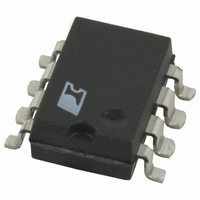DPA423GN Power Integrations, DPA423GN Datasheet - Page 5

DPA423GN
Manufacturer Part Number
DPA423GN
Description
IC CONV DC-DC DPA SWITCH 8SMD
Manufacturer
Power Integrations
Series
DPA-Switch®r
Specifications of DPA423GN
Applications
Converter, Power Over Ethernet and Telecom Applications
Voltage - Input
16 ~ 75 V
Number Of Outputs
1
Voltage - Output
220V
Operating Temperature
-40°C ~ 125°C
Mounting Type
Surface Mount
Package / Case
8-SMD Gull Wing
Output Voltage
9 V
Output Current
1.75 A
Input Voltage
- 0.3 V to + 220 V
Switching Frequency
282 KHz to 425 KHz
Operating Temperature Range
- 40 C to + 150 C
Mounting Style
SMD/SMT
Duty Cycle (max)
79 %
For Use With
596-1195 - KIT REF DES DPA 6.6W DC-DC CONV596-1009 - KIT DESIGN ACCELERATOR DC-DC596-1007 - KIT DESIGN ACCELERATOR POE CONV
Lead Free Status / RoHS Status
Lead free / RoHS Compliant
Available stocks
Company
Part Number
Manufacturer
Quantity
Price
Company:
Part Number:
DPA423GN
Manufacturer:
PowerInt
Quantity:
200
Company:
Part Number:
DPA423GN
Manufacturer:
POWER
Quantity:
5 000
Part Number:
DPA423GN
Manufacturer:
POWER
Quantity:
20 000
Company:
Part Number:
DPA423GN-TL
Manufacturer:
POWER
Quantity:
14 500
Company:
Part Number:
DPA423GN-TL
Manufacturer:
Power Integrations
Quantity:
88 094
Part Number:
DPA423GN-TL
Manufacturer:
POWER
Quantity:
20 000
approximately 5.8 V, the control circuitry is activated and the
soft-start begins. The soft-start circuit gradually increases
the duty cycle of the MOSFET from zero to the maximum
value
source is turned off at the end of the soft-start. If no external
feedback/supply current is fed into the CONTROL pin by the
end of the soft-start, the CONTROL pin will start discharging
in response to the supply current drawn by the control circuitry
and the gate current of the switching MOSFET driver. If the
power supply is designed properly, and no fault condition such
as open loop or overloaded output exists, the feedback loop
will close, providing external CONTROL pin current, before
the CONTROL pin voltage has had a chance to discharge to
the lower threshold voltage of approximately 4.8 V (internal
supply under-voltage lockout threshold). When the externally
fed current charges the CONTROL pin to the shunt regulator
voltage of 5.8 V, current in excess of the consumption of the
chip is shunted to SOURCE through resistor R
Figure 2. This current flowing through R
of the power MOSFET to provide closed loop regulation. The
shunt regulator has a finite low output impedance Z
the gain of the error amplifier when used in a primary feedback
configuration. The dynamic impedance Z
pin together with the external CONTROL pin capacitance sets
the dominant pole for the control loop.
When a fault condition such as an open loop or overloaded output
prevents the flow of an external current into the CONTROL
pin, the capacitor on the CONTROL pin discharges towards
4.8 V. At 4.8 V auto-restart is activated which turns the output
MOSFET off and puts the control circuitry in a low current
Figure 5. Typical Waveforms for (1) Power Up (2) Normal Operation (3) Auto-restart (4) Power Down.
V
V
V
Note: S0 through S7 are the output states of the auto-restart counter
LINE
C
V
DRAIN
0 V
0 V
0 V
0 V
OUT
over approximately 5 ms. The high voltage current
V
UV
1
S7
S0
2
S1
E
controls the duty cycle
S2
C
of the CONTROL
S6
E
as shown in
S7
C
that sets
3
S0
S1
S2
standby mode. The high-voltage current source turns on and
charges the external capacitance again. A hysteretic internal
supply under-voltage comparator keeps V
of typically 4.8 V to 5.8 V by turning the high-voltage current
source on and off as shown in Figure 5. The auto-restart circuit
has a divide-by-8 counter that prevents the output MOSFET
from turning on again until eight discharge/charge cycles have
elapsed. This is accomplished by enabling the output MOSFET
only when the divide-by-8 counter reaches full count (S7).
The counter effectively limits DPA-Switch power dissipation
as well as the maximum power delivered to the power supply
output by reducing the auto-restart duty cycle to typically 4%.
Auto-restart mode continues until output voltage regulation is
again achieved through closure of the feedback loop.
Oscillator and Switching Frequency
The internal oscillator linearly charges and discharges an internal
capacitance between two voltage levels to create a sawtooth
waveform for the pulse width modulator. The oscillator sets
both the pulse width modulator latch and the current limit latch
at the beginning of each cycle.
The nominal switching frequency of 400 kHz was chosen to
minimize the transformer size and to allow faster power supply
loop response. The FREQUENCY pin, when shorted to the
CONTROL pin, lowers the switching frequency to 300 kHz,
which may be preferable in some applications such as those
employing secondary synchronous rectification. Otherwise, the
FREQUENCY pin should be connected to the SOURCE pin
for the default 400 kHz.
S6
S7
2
S0
S1
S2
4
S6
S7
DPA423-426
C
S7
within a window
4.8 V
PI-3867-050602
7/05
5.8 V
P
5

















